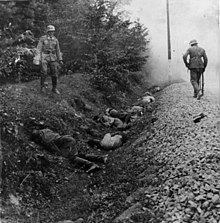Ciepielów massacre
In the Ciepielów massacre at the beginning of the attack on Poland on September 8, 1939, around 250 Polish prisoners of war were shot by the German Wehrmacht near the town of Ciepielów . The execution of prisoners is a war crime under international law .
The massacre
During the Battle of Radom , the III. Battalion of the 15th Motorized Infantry Regiment of the 29th Motorized Infantry Division along the Vistula River to conquer the bridges there. The 1st Battalion of the 74th Infantry Regiment of the Polish 7th Division under Major Józef Pelc opposed this advance near the town of Ciepielów . The soldiers of the German battalion were involved in a violent forest battle. Despite this, the Polish resistance was broken and around 450 prisoners were brought in. The losses of the participating German 11th Company amounted to 14 deaths, including the company commander, Captain Mark von Lewinski. The German regimental commander Lieutenant Colonel Walter Wessel is said to have got into a rage and ordered the prisoners to be shot. 250 prisoners were forced to undress and surrender their ID cards because, according to the regimental commander, they could be treated as partisans without their uniforms and thus shot. After the Polish soldiers were shot with submachine guns , their bodies were buried in a ditch. The remaining prisoners are said to have been taken to the rear area, where 50 other prisoners are said to have been shot by a German armored car.
According to a slightly different representation, about 40 Polish soldiers were killed in the forest battle, while 100 more were injured. Lieutenant Colonel Wessel is said to have ordered the execution of 150 prisoners, including the wounded, after the battle. The following day, another unit of the 29th Infantry Division carried out further shootings. Subsequently, a total of around 300 bodies were buried by the local Polish population, from which, however, the number of Polish soldiers who regularly fell in combat would have to be deducted.
post war period
The case first became known in August 1950 when an anonymous letter was received at the Polish consulate in Munich . It contained the private notes of a German eyewitness and two photographs. Almost 20 years later, the Polish Main Commission to Investigate Nazi Crimes sent the recordings to the central office of the State Justice Administration in Ludwigsburg . As a result, investigative proceedings against unknown persons were initiated because the responsible Lieutenant Colonel Wessel had already died in Italy during the war . Testimony of surviving members of the 15th Infantry Regiment (motorized) did not produce any results. On January 10, 1971, the proceedings were discontinued. The reason stated that 13 German and 250 Polish soldiers were killed in the battle near Ciepielów. Thus, the author of the order declared the killed Poles to be soldiers killed in action .
literature
- Jochen Böhler : Prelude to the war of extermination. The Wehrmacht in Poland in 1939 . A publication by Dt. Warsaw Historical Institute. Fischer Taschenbuch Verlag, Frankfurt am Main 2006, ISBN 3-596-16307-2 (Fischer Taschenbuch: Die Zeit im Nationalozialismus 16307).
- Jochen Böhler: “Tragic Entanglement” or Prelude to the War of Extermination? The Wehrmacht in Poland in 1939 . In: Klaus-Michael Mallmann, Bogdan Musiał (Ed.): Genesis of the Genocide. Poland 1939-1941 . Wissenschaftliche Buchgesellschaft, Darmstadt 2004, ISBN 3-534-18096-8 , pp. 36–56 ( publications by the Ludwigsburg Research Center of the University of Stuttgart 3).
- Janusz Piekałkiewicz : Polish campaign. Hitler and Stalin smash the Polish Republic . Bechtermünz, Augsburg 1998, ISBN 3-86047-907-5 .
- Robert Seidel: German occupation policy in Poland. The Radom District 1939–1945 . Schöningh, Paderborn et al. 2006, ISBN 3-506-75628-1 , ( Schöningh collection on past and present ), (At the same time: Münster (Westphalia), Univ., Diss., 2004).
Web links
Individual evidence
- ↑ OKŚZpNP w Lublinie poszukuje osób mających wiedzę dot. zbrodni popełnionych we wrześniu 1939 przez żołnierzy 29 Dywizji Wehrmachtu na terenie Lipska, Ciepielowa i okolic . Instytut Pamięci Narodowej . Retrieved February 24, 2019.
- ↑ Jochen Böhler: “Tragic Entanglement” or Prelude to the War of Extermination? - The Wehrmacht in Poland 1939. In: Klaus-Michael Mallmann, Bogdan Musial (Ed.): Genesis of Genocide - Poland 1939–1941. Darmstadt 2004. p. 48f.
- ^ Robert Seidel: German Occupation Policy in Poland - The Radom District 1939–1945 , Paderborn / Munich / Vienna / Zurich 2006, p. 178.
- ↑ Jochen Böhler: Prelude to the War of Extermination - The Wehrmacht in Poland 1939. Frankfurt / Main 2006. S. 172f.

